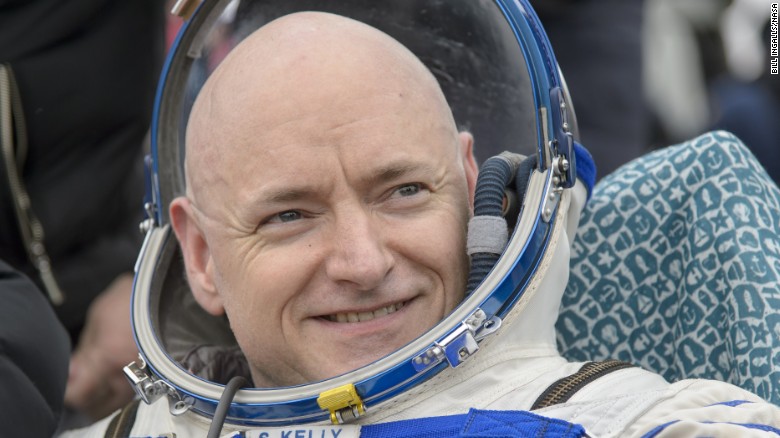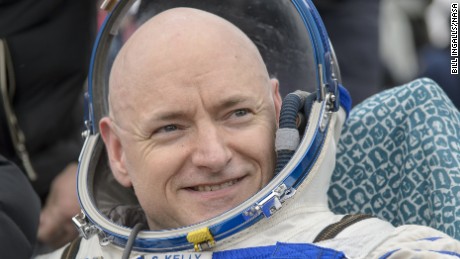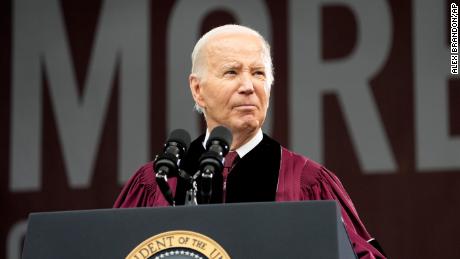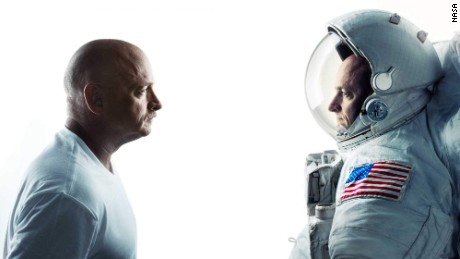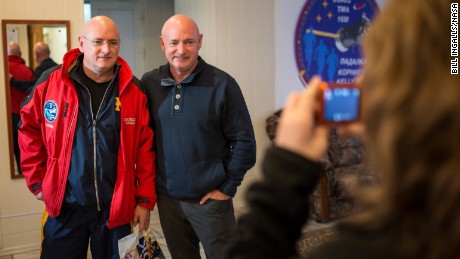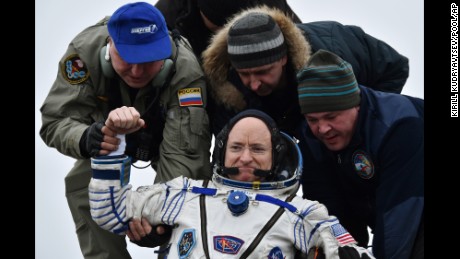(CNN)Spending 340 days aboard the International Space Station between 2015 and 2016 caused changes in astronaut Scott Kelly's body, from his weight down to his genes, according to the results of the NASA Twins Study, released Thursday.
The majority of changes that occurred in Kelly's body, compared with his identical brother, Mark, on Earth, returned to normal once he came back from the space station. The study results suggest that human health can be "mostly sustained" for a year in space, the researchers said.
On a call with reporters Thursday, Mark thanked Scott for his service to the country and commitment to science by spending a year in space without knowing how it would affect him.
"I got all the glory, and you got all the work," Scott said, chiding his twin.
"And I got people coming to my house for tubes of blood," Mark replied in reference to the scientific samples taken during Scott's mission; Scott was collecting the same samples from himself to send back to researchers on Earth.
CNN Films' 'Apollo 11'
Explore the exhilaration of humanity's first moon landing through newly discovered and restored archival footage. Watch the TV premiere of this documentary Sunday, June 23 at 9 p.m. ET/PT.
The results show "the resilience and robustness of the human body," said Steven Platts, deputy chief scientist for NASA's Human Research Program, which coordinated the study.
Coincidentally, the results are being released just in time for the 58th anniversary of the first manned spaceflight by Soviet cosmonaut Yuri Gagarin.
But the much-anticipated study reveals areas that may require countermeasures or safeguards when preparing for longer space missions or missions to deep space, like Mars.
The molecular, physiological and behavioral changes were divided into low-, mid-level and high-risk groups. Scott's change in body mass and microbiome were considered low-risk. Shifts in collagen regulation and blood vessel fluid management were mid-level, and genomic instability was regarded as potentially high-risk.
"When we go into space and experience microgravity and travel at speeds like 17,500 miles an hour, our bodies adapt and continue to function and, by and large, function extremely well," Platts said.
The study, which includes the work of 84 scientists who made up 10 teams from 12 universities in eight states, all studying different aspects of the human body in space, was published Thursday in the journal Science. The data included cognitive measurements, physiological data and 27 months of samples from both brothers, including blood, plasma, urine and stool.
However, there are limiting factors to the study, the researchers said.
The work is reflective of only Scott and Mark Kelly, and the results will not be corroborated with other astronauts, the researcher clarified. Scott was also still within the protective shield of Earth's magnetic field on the space station, not bombarded by deep-space radiation.
"It is impossible to attribute causality to spaceflight versus a co-incidental event," according to the study, so the researchers regard their work as "hypothesis-generating and framework-defining" that will benefit from more research in the future. But they also believe it's the "dawn of human genomics in space," according to Dr. Andy Feinberg, principal investigator and professor of medicine at the Johns Hopkins School of Medicine.
"The Twins Study has been an important step toward understanding epigenetics and gene expression in human spaceflight," said J.D. Polk, chief health and medical officer at NASA Headquarters. "This has helped inform the need for personalized medicine and its role in keeping astronauts healthy during deep space exploration, as NASA goes forward to the Moon and journeys onward to Mars."
Mark Kelly said he hopes it will happen in his lifetime. "I'd even volunteer to be the person to get to go now that we know this about my brother, Scott."
But he'll have to beat out his brother for that honor. "I'm ready to go. Put me on a two-year flight," Scott said.
What changed in space
A year in space caused Scott's carotid artery to thicken, DNA damage, gene expression changes, a thickening of the retina, shifts in gut microbes, reduced cognitive abilities and a structural change at the ends of chromosomes called telomeres. But it did not alter or mutate his DNA.
Getting a flu shot in space also worked exactly as it did on Earth. Nutrition and exercise while on the station caused weight loss and an increase in folic acid that caused the vital production of red blood cells.
The changes in gene expression were connected to DNA repair systems and the immune system. More than 1,000 genes changed as soon as Scott arrived in space. Some of the changes were expected, like those related to bone formation or repairing DNA, because astronauts lose bone density in space and radiation damages DNA. But the changes to mitochondrial and immune system genes, which help produce energy and protect the body, suggest that long-term spaceflight increases stress on the body. There was also evidence of cellular stress.
This reveals that Scott's immune system was on high alert in response to his environmental change, the researchers said.
"Gene expression changed dramatically," said Christopher Mason, one of the study authors and associate professor of physiology and biophysics at Weill Cornell Medicine. "While many of the changes reversed after Scott returned to Earth, a few remained, including cognitive deficits, DNA damage and some changes in T-cell activation. We don't know yet if these changes are good or bad. This could just be how the body responds, but the genes are perturbed, so we want to see why and track them to see for how long."
There was also a more dramatic change in genes during the last half of the mission compared with the first half, with six times the number of genes changing later.
Looking at Scott and Mark's epigenomes only revealed a less than 5% difference. Epigenomes are chemical compounds that act like a switch to turn genes on or off in DNA. Epigenentic changes are tweaks to gene activity that don't change the genetic code. For Scott, the changes involved his immune system response and in biochemical markers attached to inflammation.
While in space, the caps on the ends of chromosomes called telomeres lengthened in Scott's white blood cells. Usually, a change in telomere length is associated with aging or disease, and they shorten with age. The lengthening wasn't expected. Telomeres act like a biomarker for health and, now, the long-term risks of spaceflight.
Upon returning to Earth, Scott's telomeres quickly shortened and even lost length compared with how they were before he left for the space station. This could be a negative effect on his cellular health, the researchers said. Now, he has more short telomeres. Short telomeres are associated with a higher risk for accelerated aging, cardiovascular disease and some cancers, said Susan Bailey, study author and Colorado State University professor.
Scott's eyeballs also changed shape. His retinal nerve sthickened, and folds appeared in the choroid layer around the eye. The changes are associated with vision clarity and have been noted in other male astronauts because of the headward fluid shift of zero gravity. It's called space-associated neuro-ocular syndrome or SANS. That same fluid shift caused a distension of the neck's jugular vein, more cardiac output and a thickening of the forehead's skin. This puts deep pressure on veins, eyes and blood vessels and causes drainage.
The fluid shift affected not only his eyes but his cardiovascular system, as well. Scott's carotid artery wall thickened early in the mission and remained that way for the rest of the flight. Collagen levels in his blood shifted, which was associated with changes in cardiovascular risk factors. Those returned to baseline when he returned.
While Scott's gut microbiome shifted, the diversity of it didn't, which was encouraging to researchers. Comparing Scott's samples before, during and after the flight was more valuable than comparing them to Mark's, the researchers said. While in space, the number of gut bacteria called Firmicutes increased, while the gut bacteria Bacteroidetes decreased. Both categories contain a mix of good and bad bacteria.
Researchers believe that zero gravity caused this shift. But the balance returned to normal when Scott returned to Earth. Countermeasures to help maintain this balance in the future could include pre-, pro- or postbiotics.
Scott's cognitive speed and accuracy decreased in tests postflight and persisted up to six months after he returned.
There was also an uptick in immune response during Scott's landing on Earth, which aligns with such a stressful event. And his lactic acid levels were higher during the first 15 days and final 14 days of the trip, although the exact trigger has not been identified.
But almost everything returned to normal, stable or baseline levels six months after Scott returned to Earth.
Scott said that returning from a year in space was "significantly different" from returning from a six-month mission. "The return was much worse than the adjustment" to the space station.
Scott said he felt like he had the flu during his first few days back on Earth. He experienced joint and muscle pain, swelling in the lower legs, hives and rashes anywhere his skin touched anything, dizziness, nausea and fatigue.
He believes it was all due to the return to gravity, exposure to different people and their immune systems, and an emotional reaction to such a dramatic experience. It took about six months to feel 100% again.
"He is back to virtually normal," said Dr. Mike Snyder, investigator and director for Stanford University's Department of Genetics.
Platts said that "if you look at the changes that were seen in Scott, the vast majority of them came back to baseline at a relatively short period of time when he returned to Earth, and those that did not return very quickly were markers of things we already knew were likely to happen," such as stress and inflammatory markers.
He said the study both has new findings and reinforces what was known.
Protecting astronaut health
Scott first proposed the idea to NASA's Human Research Program before his mission. The twins are both astronauts, but a unique opportunity was presented when Scott planned to spend a year on the space station while his brother remained on Earth. Their identical genes would provide the perfect comparison for researchers. And going forward, NASA is proposing more one-year missions to continue this kind of research and to prepare for longer missions to Mars or the moon.
After more than 50 years of human spaceflight, researchers know some of the risks posed to the human body by being in zero gravity. Astronauts have to deal with a stressful environment, noise, isolation, disrupted circadian rhythm, radiation exposure and a headward fluid shift that happens when floating as opposed standing on solid ground.
Space motion sickness occurs in the first 48 hours, creating a loss of appetite, dizziness and vomiting.
Over time, astronauts staying for six months or more on the station can experience the weakening and loss of bone and muscle atrophy. Astronauts also experience blood volume loss, weakened immune systems and cardiovascular deconditioning since floating takes little effort and the heart doesn't have to work as hard to pump blood. Scott and other astronauts in their late 40s and 50s have also complained about their vision being slightly altered. Some of them have required glasses in flight.
Going forward, NASA is focused on addressing the key threats to humans traveling in space: isolation and confinement, radiation, distance from Earth, hostile or closed environments and fluctuating gravity.
"This will guide future biomedical space research and allow us to have a safer journey to and from Mars," Platts said.
Implications on earth too
But these findings don't just have implications for astronauts. Cancer patients also undergo genetic changes and radiation exposure. This study shows how a healthy body responds and adapts to stress, which could separate out how the body responds to other stressors, cancer or infections.
"The science that we do in space impacts our nation for generations," Mark Kelly said.
In addition, the study sheds light on individual responses to flu vaccines, environment-related changes in gene expression, ailments related to intracranial pressure, visual system impairments and cardiovascular diseases like atherosclerosis.
Bailey, the telomere researcher, will continue her work by studying astronauts on six-month and one-year missions. Understanding the individual factors behind telomeres could show what influences their dynamics.
"The Twins Study demonstrated on the molecular level the resilience and robustness of how one human body adapted to the spaceflight environment," said Jenn Fogarty, chief scientist for NASA 's Human Research Program. "This study was a stepping stone to future biological space research focusing on molecular changes and how they may predict health and performance of astronauts. It opened the door to new research strategies that are already being advanced in other studies."


